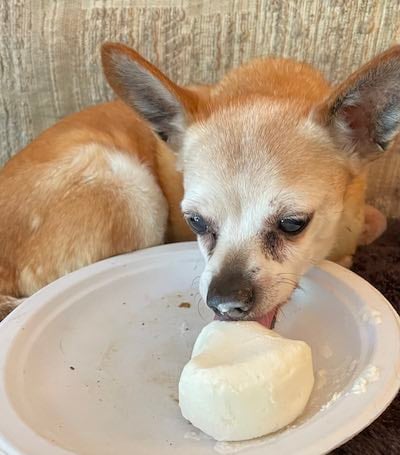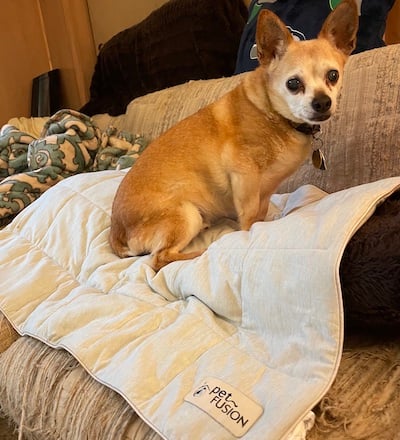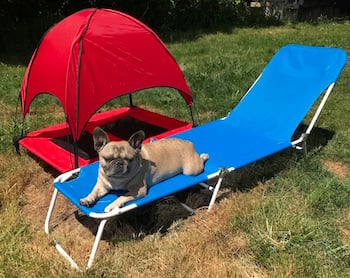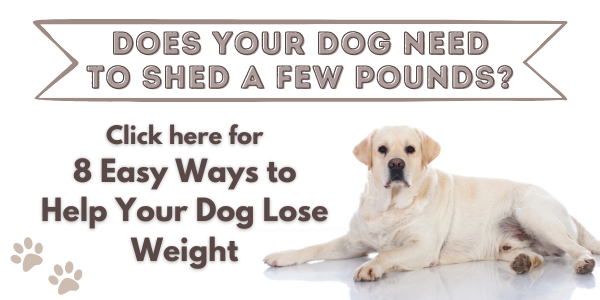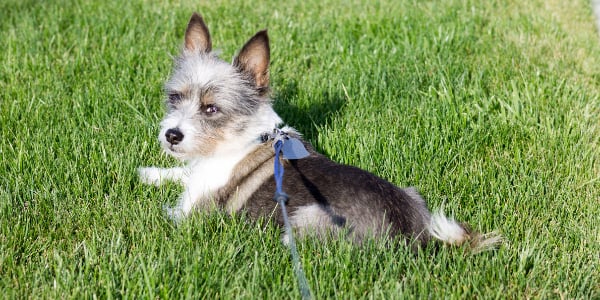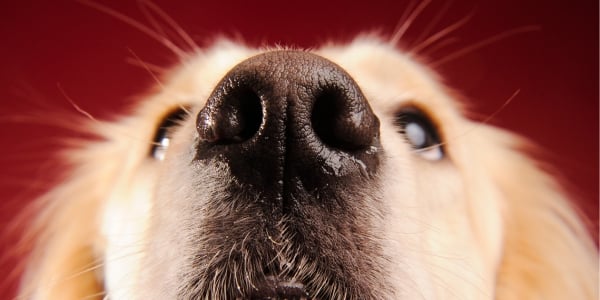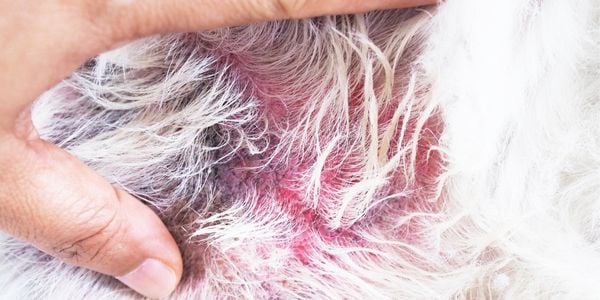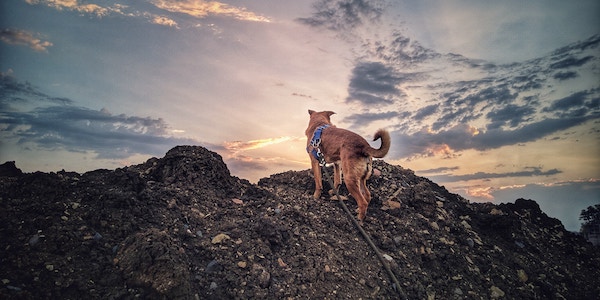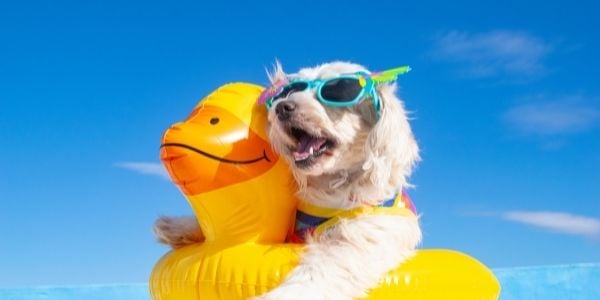 Summer is my favorite season. The pollen is (mostly) gone, trees and flowers are in full bloom, and it is HOT outside!
Summer is my favorite season. The pollen is (mostly) gone, trees and flowers are in full bloom, and it is HOT outside!
While our dogs may love basking in the sunshine with us, this time of year means we need to take extra precautions to prevent them from heatstroke or heat exhaustion. This is especially true for flat-faced (brachycephalic) breeds like French Bulldogs, Pugs, and Shih Tzus, among others.
None of us like to see our pets suffering from the heat. So, when summer temperatures rise, we need to be sure to provide them with easy ways to stay cool.
Skip Ahead
The Risk of Heat Stroke in Dogs
If you need to cool your dog down immediately, check out our heatstroke article for tips and advice. Signs that your dog is overheated include:
- Excessive panting or drooling
- Weakness
- Disorientation
- Gums and/or tongue change color (to a bright red or bluish)
When a dog’s body temperature becomes elevated, exceeding 106° F (with no known illness), it's termed a heat stroke since it is due to excessive heat from the environment or external source. When a dog’s body temperature reaches around 107° F, multiple organs begin to fail, and death can occur. Naturally, we all want to avoid this horrible situation.
As a reminder — NEVER leave your dog alone in a hot car. It can be fatal. Even if you are parked in the shade and have the windows down, it can still be too hot for your dog. They can become distressed and uncomfortable very fast. It is always best to preplan any trip your dog may be taking with you and pack the necessary items to help keep your dog cool and hydrated.
How Dogs Naturally Cool Down
Dogs don't sweat through their skin as we do. While they do sweat through their paw pads, it's not the main way they cool down.
A dog regulates their body temperature through panting. Moisture is evaporated from their tongues, nasal passages, and the lining of their lungs as they pant. As this air circulates through their body, it helps cool them off.
Ways to Keep Your Dog Cool in the Summer
Click here to see all of the products mentioned in this article (and more of our favorites).
Chilled Summer Dog Treats
Keep your dog hydrated by making them an icy treat. It can be as easy as putting your dog's favorite toys and treats in a metal dog bowl, filling it with water (and you can add a little bit of low-sodium chicken broth – no onions or garlic! – for an additional incentive), then freeze and serve.
Here's a video of Wendy the dog enjoying one of these frozen bowl treats:

Smear some low-fat plain Greek yogurt, peanut butter (make sure it's xylitol-free!), banana, or wet dog food onto a licking mat and freeze for a quick and cooling afternoon dog snack.
To help with hydration, you can give your dog fruits or veggies that are predominately water. Be sure not to let them consume any pits or seeds. Some high-water-content options include cucumbers, zucchini, celery, watermelon, apples, or peaches. Click here for more dog-safe fruit options.
Use mealtime to cool your dog down. Mix your dog's regular meal with water, a little bit of watered-down wet food, or other dog-safe liquid-based options, stuff into a Toppl, and freeze. It's easy to prep these meals ahead of time, so you can just grab one from the freezer and give it to your dog.
Not only do frozen dog feeders help cool off your dog, but they provide great mental enrichment. Enrichment helps burn excess energy, especially on hot days when outdoor exercise just isn't safe.
Check out Choosing the Best Interactive Dog Toys and Puzzles for more of our favorite stuffable and freezable options.
Make Pupsicles
There are lots of popsicle recipes for dogs, but it doesn't have to be complicated!
Be sure to use unsweetened and xylitol-free yogurt if the pupsicle recipe calls for yogurt. And you don't want to give yogurt to dogs that are lactose-intolerant. Here's a lactose-free pupsicle option that only requires two ingredients:
- Place 1 1/2 cups watermelon in a food processor or blender and mix until smooth. Pour into a cup and set aside.
- Place 1 1/2 cups pineapple in a food processor or blender and mix until smooth and frothy. (Not frothy enough? You can add a bit of coconut milk to make it creamier.) Pour into a cup.
- Fill a silicone mold cup halfway with the pineapple puree, and then follow with the watermelon puree. You can leave layered or slightly mix the two purees for a tie-dye effect.
- Freeze until solid, then pop one out and give it to your pup!
Here's a Preventive Vet friend, Mr. B, a super senior Chihuahua, enjoying his frozen yogurt pupsicle during a heat wave this past summer:
Dog Cooling Vests and Mats
As mentioned earlier, our four-legged buddies don’t sweat through their skin like us. Instead, they predominantly cool themselves through their respiratory system — this is why dogs pant when they're hot. Cooling jackets for dogs can help by mimicking sweating across the dog's body. As the water from the coat evaporates, it helps to move heat from the dog’s body outwards to the environment.
These vests are not fail-proof nor a replacement for the careful and cautious exercise of dogs on warm/hot days, but can be a nice aid on warmer days (just be sure to “recharge” the coat regularly by dousing it with water, as per the instructions). We like the Ruffwear Swamp Cooling Vest and the Hurtta Cooling Dog Jacket — both work similarly. Or, if you already use a Ruffwear harness, they offer a Core Cooler Vest that attaches to all of their harnesses or packs.
One word of caution for high humidity: These types of cooling vests will be less effective on humid days, as evaporation diminishes on days where there’s already a lot of moisture already in the air.
Cooling collars or bandanas like this one can help a little, as does wetting your dog's fur with cool (but not ice-cold) water every once in a while. This type of bandana or collar may not work as well on a dog with a thick coat of fur around their neck.
Cooling mats or blankets can provide a perfect spot for your dog to rest and stay cool. And they are easy to take anywhere. You can place these in the shade outdoors or for your dog's normal indoor resting spots. These can come in handy if you don't have cool tile or wood floors or if your dog sleeps in their crate or pen during hot summer nights.
Some of Preventive Vet's dogs love using the Green Pet Shop Dog Cooling Mat in the car after going to the park. It fits perfectly in the back of a Honda CRV. The mat is self-cooling and pressure-activated, so it doesn't need to be refrigerated to work.
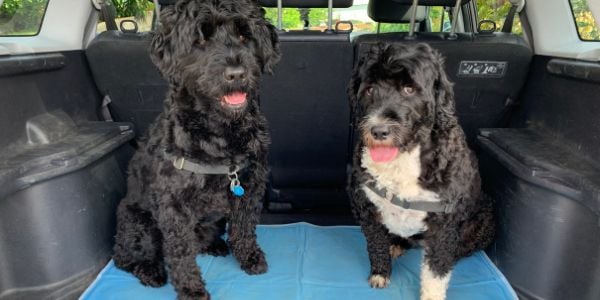
What to Avoid: Never allow any pet, especially those with mobility issues, to lay directly on ice or ice packs, as this can lead to ice burns.
Since brachycephalic (flat-faced) dogs do better when cooler, these cooling mats can benefit them year-round, especially in homes that keep the heater on high during the winter months. Additionally, senior pets that may struggle to get comfortable in the heat can benefit from cool resting mats.
If you have a dog who loves to "nest" and get cozy, but it's too hot to burrow under regular blankets, try out a cooling blanket. These blankets pull heat out and away from their body – one of our Preventive Vet team members was blown away by how well it worked and has taken to using it herself. Mr. B loves to cuddle up in blankets and loved having a cooler option to burrow into.
Dog Pools & Water Fun
Set up a small pool for your dog. You can get a small plastic kiddie pool or invest in a "dog pool," like this sturdy, easy-to-set-up and drain, foldable pool. Be sure to fill it with fresh cool water each morning and properly clean it in the evenings. Providing shade over the pool will help keep the water cooler throughout the day.
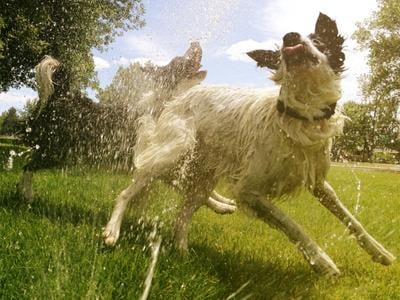 Pools come in a variety of different sizes, so be sure you get the one that's the right size for your dog. Choose a durable material, especially if your dog likes to "dig" in the water – avoid inflatable pools as a dog's nails may puncture the bottom or sides.
Pools come in a variety of different sizes, so be sure you get the one that's the right size for your dog. Choose a durable material, especially if your dog likes to "dig" in the water – avoid inflatable pools as a dog's nails may puncture the bottom or sides.
Never leave your dog unattended in the pool, and be sure to not fill it up too high, especially if your dog is a puppy, senior dog, or just not all that steady on their paws or "sure of themselves" in the water.
Add more water fun to your dog's outdoor play by setting up an oscillating yard sprinkler and letting your dog run through and play in it.
Clean and dry the inside of your dog’s ears with a veterinary-approved ear cleaner at the end of the day after playing in the water to help avoid ear infections.
When Too Much Water is a Bad Thing: Some dogs may lap up tons of water while they play in their pool, run through the sprinkler, or chase the hose spray. Or your dog may chug from their water bowl. Don't allow your dog to drink excessively (too much, too fast). Overconsumption of water can lead to water intoxication, where sodium levels in your dog's body are depleted.
The symptoms of water intoxication include nausea, vomiting, bloating, dilated pupils, glazed eyes, excessive salivation, staggering, and lethargy. Drinking excessively can lead to bloat, especially if your dog exercises before or after doing so.
Provide Dog Water Stations in Your Home or Yard
Providing your dog with plenty of cool water to drink is essential in the heat. Just like us, they can get dehydrated. Plus, nothing feels better on a hot day than a cool drink.
Provide several large bowls of drinking water for your dogs around your home or yard, making sure to check and refill them at least once per day. Be sure to place them where your dog can easily reach them, and try to put them in cooler areas or with reliable shade.
You can even get automatic waterers that easily attach to your garden hose, a "lick-activated" spigot attachment (it will likely take some time/work to train your dog to use it – think, gerbil drinking from a water bottle!), or even a "paw-activated" water geyser.
Can Dogs Have Ice Water?
Don’t worry about giving your dog ice water — it doesn’t cause bloat. And while ice is ok for dogs, just watch so they don’t end up breaking a tooth while chewing on it (this is where crushed ice may be a better option). Also, monitor that they don’t choke on an ice cube.
Provide Lots of Shade for Your Dog
If you have a yard or outdoor space, you'll want to take advantage of natural shade or create some of your own! Sometimes, depending on the heat, something as simple as a tree is great. But not all yards have trees, or the direction of the sun means they don't provide shade where you need it. So what can you do?
Portable sunshades, patio umbrellas, and pop-up canopies are great for creating shade in yards and on patios. There are even some products that combine the shade of a pop-up canopy with the cooling effect of a misting system.
A popular portable shade option used by dog sport enthusiasts is the Aluminet Shade Cloth, which can be draped over ex-pens, wire crates, or over the back of an open car hatchback while you're waiting between events with your dog. It's made from a reflective material to reduce heat and provides airflow with a loosely knitted design. Here's an example of how one dog sport enthusiast sets up the shade cloth over their car, with the back hatch open, the dog in a wire crate in the back, and a Ryobi portable fan attached to the crate to keep the air moving:
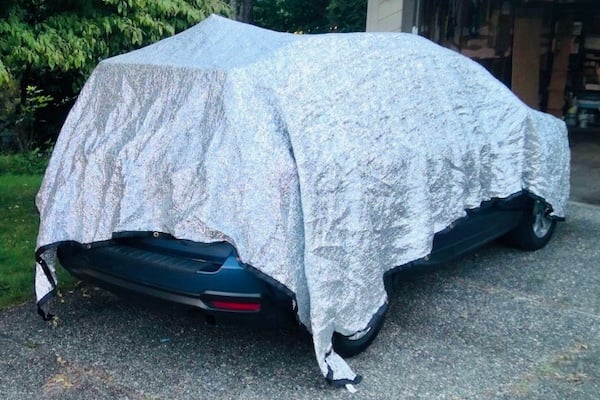
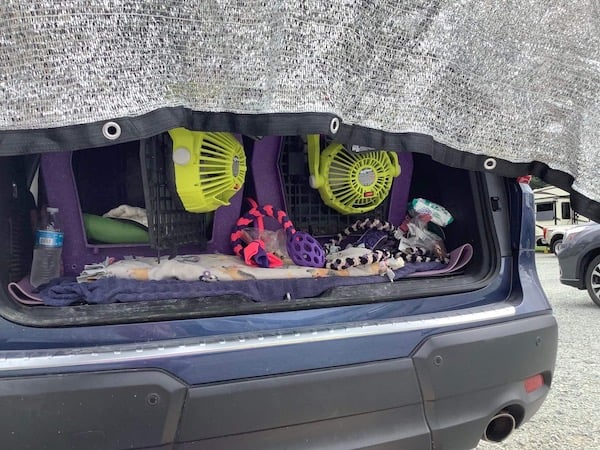
Safety Note: Pets should never be left in a closed car, even with shade cloth over their carrier or over the car.
Use Raised Dog Cots
Some yards are just not big enough for canopies or shade cloth, or you may have an apartment patio or deck, so smaller may be better. Consider a raised and shaded pet cot. They provide reliable shade and are quite portable. Choose a pet cot that's elevated off of the ground, which helps with air circulation and cooling.
To make your dog's raised cot and canopy area extra cool, you can put a pan of ice below the cot. This cools the air under the bed, helping to keep your dog a bit comfier. You can also wet down the surface of the cot as another option to keep it cooler. And you should keep these raised cots on cooler surfaces anyway (e.g., grass rather than asphalt or concrete).
What About Dog Houses for Shade During Hot Weather?
While leaving your dog unattended for hours outside on a hot day isn't recommended, many people feel that their dog will be protected from overheating if they seek shade in their dog house. The truth is the wrong type of dog house may end up being harmful. Depending on the type of dog house, the temperature inside can become unsafe — similar to a car sitting in the sun. Some designs prevent proper airflow, which can be dangerous and cause your dog to overheat.
If your dog has an outdoor dog house, it should be in a shaded area and elevated off the ground. This prevents direct sun from heating it up and from it absorbing heat from the ground. A dog house that is meant for the summer has less insulation which means it won’t hold in as much heat. It should have one or more vents to help keep the air flowing and the inside temperature cooler.
Stay Indoors During the Hottest Hours of the Day
Perhaps the most obvious suggestion is that you and your dog stay inside with the air conditioning blowing, especially during the hottest part of the day. But not everyone has AC, and not everyone, including your dog, may want to be trapped inside binge-watching TV shows.
But if possible, limit outdoor time during the hottest hours of the day and have your dog in the coolest area of your home.
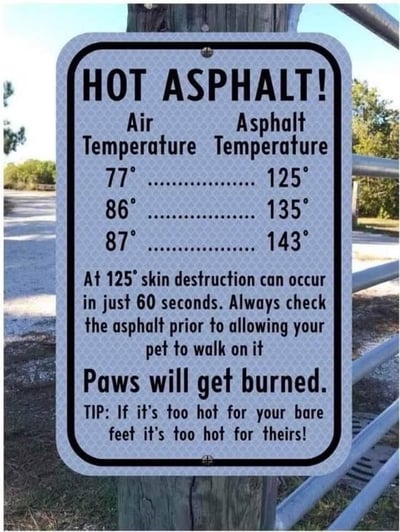
Early Morning and Late Evening Walks
Dogs still need to burn some energy, even on hot days. Since you want to avoid physical exertion during higher temperatures, venture outside early in the morning and later in the evening when the temperatures are lower. For your evening excursion, check the temperature of the ground to make sure it's not too hot for your dog's paws.
Asphalt, dirt, and sand can get very hot after the sun's been beating down on it all day. And that hot surface can quickly burn your dog's paw pads.
If you put the back of your hand against the hot surface for 5 to 7 seconds, and it's too hot for you, then it's too hot for your dog's paws. Read more about protecting your dog's paw pads and our favorite dog booties here, including how to help your dog get comfortable wearing them.
While on your early morning or late evening walks, bring along a portable water bowl or have a dedicated dog water bottle. You need to have enough water for the entire outing.
While out walking or hiking, give your dog a small amount of water every 15 to 20 minutes so their stomach has time to absorb it. It isn’t good to let them get too much water at one time.
Use Fans to Keep Your Home Cool
If you don't have air conditioning, fans can be a good way to keep the air flowing. To cool down your house using fans, the air outside will need to be cooler than the air inside — so do the following early in the morning, later in the evening, and overnight:
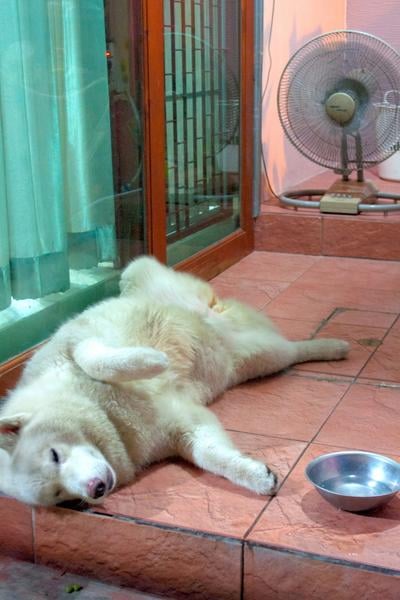 Place a fan in a window that's along the coolest side of the building (typically with the most shade) with the fan pointing into your home – this pulls in cooler air.
Place a fan in a window that's along the coolest side of the building (typically with the most shade) with the fan pointing into your home – this pulls in cooler air.- Then place another fan in a window on the opposite side of your home, but with it facing out the window – this pushes warmer air out.
- Get as much cross breeze as you can by placing as many fans as possible in the above setup.
- Keep indoor doors open, so air can flow more easily.
- For multi-level homes, have the fans in upper-level windows on the hotter side of your home, pulling warm air out. Place fans in windows on the cooler side of your home on the lower level, pulling cooler air in. Hot air rises!
When the air temperature outside rises, you'll want to close the windows of your home to keep that hot air out and close curtains or blinds to block sunlight.
To create a DIY air conditioner, place a large bucket of ice or frozen water bottle (covered with a damp towel) in front of a box fan or tower fan. To keep your dog from helping themselves to the ice, place this setup out of their reach, such as on a chair, counter, or behind a dog gate.
If you have a small patio, make an outdoor fan even better by attaching a misting system! Especially if you can provide some additional shade above, they can potentially lower the temperature by 10 degrees. That may not seem like much, but to your dog, it can be.
Keep Your Dog at a Healthy Weight to Prevent Overheating
Overweight dogs have a harder time keeping cool in warm weather and are at greater risk of overheating. Extra weight is an even bigger concern for brachycephalic breeds (Bulldogs, Pugs, Frenchies, etc.) during the summer. These breeds struggle in warmer weather to breathe, but the situation is worse when they are overweight, and it is hot.
Help your dog by keeping them in an ideal body condition. Measuring their food, monitoring the number of treats (and the calories per treat), and stopping all table food will help them drop some weight. Your veterinarian can help guide you on how much to feed your dog and what your pet’s ideal body weight is.
Brush Your Dog's Coat Regularly to Keep Them Cool
Keeping your dog regularly groomed in the summer is important. Your dog’s coat doesn’t just insulate them and keep them warm in the winter it also helps keep them cooler in the summer and protects their skin against sunburn.
Matted or compacted fur close to the skin traps heat. Brush your dog regularly to help get out any undercoat that they’re “blowing” from the winter/cooler months (which was there to help keep them warm). Brushing will remove any compacted fur from their undercoat, which allows for proper airflow along their skin.
Should You Shave Your Dog's Coat to Keep Them Cool?
If your dog has a double coat, do not shave them in an effort to keep them cool during hot weather. This can have the opposite effect! Double-coated breeds, such as Huskies, Corgis, Labs, etc., should never be shaved unless directed to do so by a veterinarian.
If your dog has a single-layer coat (such as a Poodle, Labradoodle, Yorkie, etc.), shaving their coat will not cause damage to their fur like it would a double-coated breed. However, they are at a higher risk of sunburn with shorter coats.
Sun Protection and Sunscreen for Dogs
Since dogs can get sunburn and skin cancer just like us, you may want to use UV-blocking clothes and/or sunscreen on your pup when they're outdoors on sunny days. There are several brands of UPF sun-blocking clothes for pets out there, and a lot of what will work best for your pup will be dependent on how it's sized. But, all other things being equal, try and go with the shirts, visors, or dog sun goggles that have the highest UPF rating.
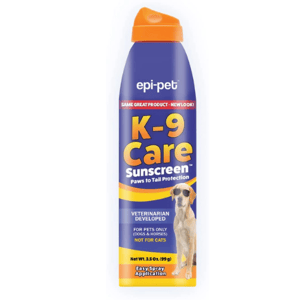 As for sunscreen for your pup, this is especially important if they've got a thin or non-existent coat ... I'm looking at you, Chinese Cresteds. If you need to or decide to shave them (see the note above re: shaving dogs in the summer), apply sunscreen on the typically hairless or thin-coated areas (their belly, tips of ears, and bridge of their nose).
As for sunscreen for your pup, this is especially important if they've got a thin or non-existent coat ... I'm looking at you, Chinese Cresteds. If you need to or decide to shave them (see the note above re: shaving dogs in the summer), apply sunscreen on the typically hairless or thin-coated areas (their belly, tips of ears, and bridge of their nose).
Do not spray the sunscreen directly on or around their face. Spray it onto your hand first, then rub it onto their nose, ears, belly, or other low- or no-fur areas.
There is an FDA-approved sunscreen available for dogs, it's called Epi-Pet, and it works great.
Get more tips for preventing sunburn and protecting your dog from UV rays here.
Enjoy Your Summer with Your Dog
These are just a few ideas to get you started for enjoying summertime with your dog. Don't forget to protect yourself from the sun and heat, too!
Click here to see all of the products mentioned in this article (and more of our favorites).
If you have other ways to help keep your pet cool, we'd love for you to share them with us in the comments below.



